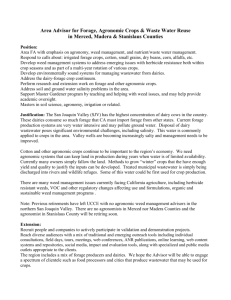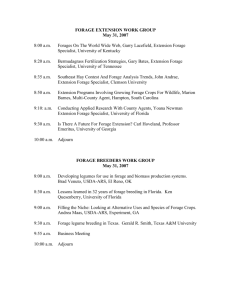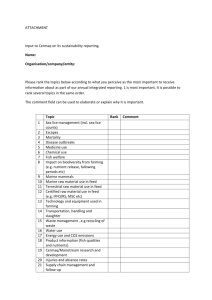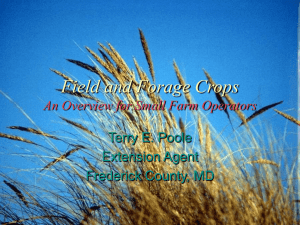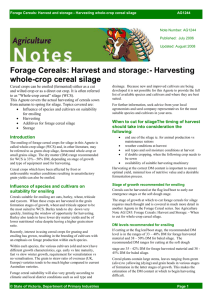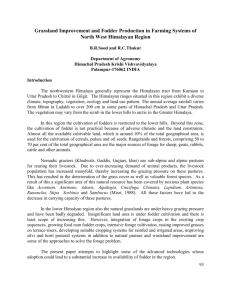A Forage Plan for all seasons - Dairy Fertility Investigator
advertisement
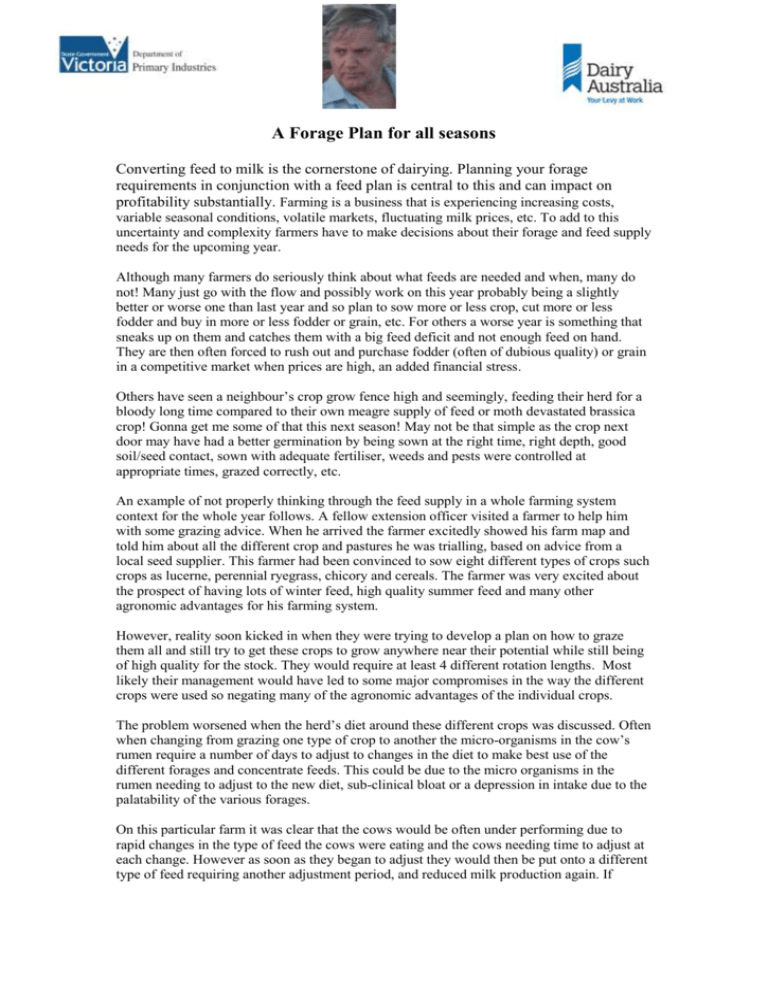
A Forage Plan for all seasons Converting feed to milk is the cornerstone of dairying. Planning your forage requirements in conjunction with a feed plan is central to this and can impact on profitability substantially. Farming is a business that is experiencing increasing costs, variable seasonal conditions, volatile markets, fluctuating milk prices, etc. To add to this uncertainty and complexity farmers have to make decisions about their forage and feed supply needs for the upcoming year. Although many farmers do seriously think about what feeds are needed and when, many do not! Many just go with the flow and possibly work on this year probably being a slightly better or worse one than last year and so plan to sow more or less crop, cut more or less fodder and buy in more or less fodder or grain, etc. For others a worse year is something that sneaks up on them and catches them with a big feed deficit and not enough feed on hand. They are then often forced to rush out and purchase fodder (often of dubious quality) or grain in a competitive market when prices are high, an added financial stress. Others have seen a neighbour’s crop grow fence high and seemingly, feeding their herd for a bloody long time compared to their own meagre supply of feed or moth devastated brassica crop! Gonna get me some of that this next season! May not be that simple as the crop next door may have had a better germination by being sown at the right time, right depth, good soil/seed contact, sown with adequate fertiliser, weeds and pests were controlled at appropriate times, grazed correctly, etc. An example of not properly thinking through the feed supply in a whole farming system context for the whole year follows. A fellow extension officer visited a farmer to help him with some grazing advice. When he arrived the farmer excitedly showed his farm map and told him about all the different crop and pastures he was trialling, based on advice from a local seed supplier. This farmer had been convinced to sow eight different types of crops such crops as lucerne, perennial ryegrass, chicory and cereals. The farmer was very excited about the prospect of having lots of winter feed, high quality summer feed and many other agronomic advantages for his farming system. However, reality soon kicked in when they were trying to develop a plan on how to graze them all and still try to get these crops to grow anywhere near their potential while still being of high quality for the stock. They would require at least 4 different rotation lengths. Most likely their management would have led to some major compromises in the way the different crops were used so negating many of the agronomic advantages of the individual crops. The problem worsened when the herd’s diet around these different crops was discussed. Often when changing from grazing one type of crop to another the micro-organisms in the cow’s rumen require a number of days to adjust to changes in the diet to make best use of the different forages and concentrate feeds. This could be due to the micro organisms in the rumen needing to adjust to the new diet, sub-clinical bloat or a depression in intake due to the palatability of the various forages. On this particular farm it was clear that the cows would be often under performing due to rapid changes in the type of feed the cows were eating and the cows needing time to adjust at each change. However as soon as they began to adjust they would then be put onto a different type of feed requiring another adjustment period, and reduced milk production again. If supplements were being fed at that time, as they often are, the type of supplement might need to be changed with each different crop type, another change in diet! To avoid the above situation, farmers could consider developing a robust forage plan which is reliable and flexible enough to handle the seasonal roller coaster that is dairy farming. There are a range of crop types and cultivars within each that will cover a wide range of sowing and maturity dates. There are also specific crops suitable for a range of specific conditions (soil temperatures, soil types, rain fall, etc.). These crops are often given an average nutritive (book) value but all species produce a wide range of nutritive values depending mainly on their maturity, but also influenced by soil fertility, moisture conditions, etc. Nowadays, a risk management approach to forage planning is also needed to help cope with seasonal uncertainty. What is your bet for the rest of this year and 2013? Weather scientists continue to update the seasonal conditions ahead using models and various measurements and sometimes get it wrong but we would be foolish to ignore/reject their advice out of hand. They haven’t been too far out, in recent years, have they?. Back to your farm’s feed and forage needs! How can you work out when and what the farm’s feed and forage needs are the for this upcoming season when no-one can even really reliably inform us of the likely future seasonal conditions? A Forage Plan will take into account your farming system, i.e. your animals’ needs (when, how much and what quality), what crops/pastures best suit your farming situation, etc. Although we don’t have control over the seasonal variation, weather conditions, cash flow, milk prices and the impact and volatility of overseas milk product prices and world grain prices (due to droughts, poor seasons, etc.) these can influence farmers’ decisions depending on their views on risk. DPI, along with support from Dairy Australia, is developing a Forage Planning process which will help farmers to plan their forage needs in a better planned, more informed way will look further into the future rather than just the next season. I will be running a pilot Forage Planning Group in early autumn 2013 with a view to developing and making available a Forage Planning process for three groups in Gippsland in 2014. The pilot group will meet several times quickly early in the season to develop a Forage Plan and discuss what to sow and why, etc. then meet again to discuss management at various stages during the growth of the pastures and/or crops at sowing, germination, grazing and conservation. The first day is planned for Thursday 14th. March in South Gippsland. Time is quickly running out with the early rains hinting at an early autumn break so I welcome and encourage any dairy farmer interested in being involved in the pilot or next year’s Forage Planning groups to contact Frank Mickan on 5624 2259, 0427 317 471 or email frank.mickan@dpi.vic.gov.au, ASAP, please. Figure 1. Which crop is best suited to your farm system? Figure 2. Which of these crops are suitable?



